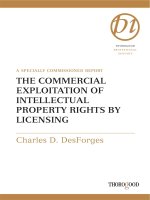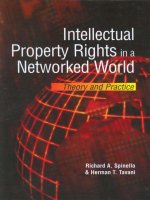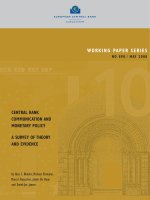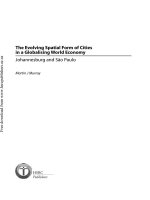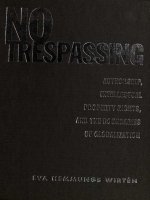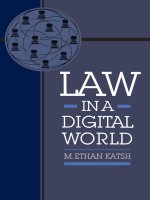Intellectual Property Rights in a Networked World: Theory and Practice doc
Bạn đang xem bản rút gọn của tài liệu. Xem và tải ngay bản đầy đủ của tài liệu tại đây (4.85 MB, 303 trang )
Intellectual Property
Rights in a
Networked World:
Theory and Practice
Richard A. Spinello
Boston College, USA
Herman T. Tavani
Rivier College, USA
Hershey • London • Melbourne • Singapore
Information Science Publishing
Acquisition Editor: Mehdi Khosrow-Pour
Senior Managing Editor: Jan Travers
Managing Editor: Amanda Appicello
Development Editor: Michele Rossi
Copy Editor: Jane Conley
Typesetter: Jennifer Wetzel
Cover Design: Lisa Tosheff
Printed at: Yurchak Printing Inc.
Published in the United States of America by
Information Science Publishing (an imprint of Idea Group Inc.)
701 E. Chocolate Avenue, Suite 200
Hershey PA 17033
Tel: 717-533-8845
Fax: 717-533-8661
E-mail:
Web site:
and in the United Kingdom by
Information Science Publishing (an imprint of Idea Group Inc.)
3 Henrietta Street
Covent Garden
London WC2E 8LU
Tel: 44 20 7240 0856
Fax: 44 20 7379 3313
Web site:
Copyright © 2005 by Idea Group Inc. All rights reserved. No part of this book may be repro-
duced in any form or by any means, electronic or mechanical, including photocopying, without
written permission from the publisher.
Library of Congress Cataloging-in-Publication Data
Intellectual property rights in a networked world : theory and practice / Richard A. Spinello,
Herman T. Tavani, editor[s].
p. cm.
Includes bibliographical references and index.
ISBN 1-59140-576-9 (hardcover) ISBN 1-59140-577-7 (pbk.) ISBN 1-59140-578-5
(ebook)
1. Intellectual property. 2. Right of property. 3. Copyright and electronic data processing. 4.
Locke, John, 1632-1704 Views on property. I. Spinello, Richard A. II. Tavani, Herman T.
K1401.I566 2005
346.04'8 dc22
2004003761
British Cataloguing in Publication Data
A Cataloguing in Publication record for this book is available from the British Library.
All work contributed to this book is new, previously-unpublished material. The view expressed in
this book are those of the authors, but not necessarily of the publisher.
For our spouses, Susan Brinton and
Joanne Tavani
Intellectual Property
Rights in a
Networked World:
Theory and Practice
Table of Contents
Foreword vi
Preface ix
SECTION I: OVERVIEW
Chapter I
Intellectual Property Rights: From Theory to Practical
Implementation 1
Richard A. Spinello, Boston College, USA
Herman T. Tavani, Rivier College, USA
SECTION II: THEORETICAL P ERSPECTIVES
Chapter II
Intellectual Property Rights in Software — Justifiable from a
Liberalist Position? Free Software Foundation’s Position in
Comparison to John Locke’s Concept of Property 67
Kai Kimppa, University of Turku, Finland
Chapter III
Locke and Intellectual Property Rights 83
Michael J. Scanlan, Oregon State University, USA
Chapter IV
Ideas, Expressions, Universals, and Particulars: Metaphysics
in the Realm of Software Copyright Law 99
Thomas M. Powers, University of Virginia, USA
SECTION III: ETHICAL AND LEGAL P ERSPECTIVES
Chapter V
Exporting Trademark Confusion 113
Ann Bartow, University of South Carolina, USA
Chapter VI
Feminism and Copyright in Digital Media 161
Dan Burk, University of Minnesota, USA
Chapter VII
Recent Copyright Protection Schemes: Implications for Sharing
Digital Information 182
Herman T. Tavani, Rivier College, USA
Chapter VIII
Trespass and Kyosei in Cyberspace 205
Richard A. Spinello, Boston College, USA
Chapter IX
New Threats to Intellectual Freedom: The Loss of the
Information Commons through Law and Technology in the US 225
Elizabeth Buchanan, University of Wisconsin-Milwaukee, USA
James Campbell, Modular Media, USA
Chapter X
Would Be Pirates: Webcasters, Intellectual Property, and
Ethics 243
Melanie J. Mortensen, Montreal, Canada
About the Authors 275
Index 278
vi
The rapid development of the “knowledge economy” has temporarily
stalled, but few doubt that it will soon be getting a second wind. This new
economy, in which a company’s major resources are its intellectual assets, has
undoubtedly moved the topic of intellectual property into sharp focus for de-
cades to come. The notion of intellectual property rights, opposed by many
cyberspace libertarians, triggers many elusive questions about the extent and
precise nature of those rights. For example, the digital music and movie revo-
lution has swept across the Web, and yet many of the vexing issues raised in
the Napster case remain unresolved.
Network and digital technologies also have the potential to usher in a
new era of decentralized creativity and public discourse. These technologies
have made it so much easier to accomplish the distribution of creative mate-
rial. So why shouldn’t we celebrate this new found freedom?
Some critics maintain that the traditional property rights system, which
tends to “propertize” all forms of information, will interfere with the realization
of this ideal. On the other hand, how can we protect the rights of artists and
content providers to distribute their creations and receive appropriate pay-
ment without preserving traditional copyright law?
Of course, intellectual property issues are not confined to the sharing of
digital music files. It is not surprising that access to digital information is be-
coming a matter of great social and economic import. Poorer countries ac-
cuse wealthy nations of “information imperialism,” contending that they can-
not overcome the digital divide unless intellectual property rights are loosened
considerably. As a result, the battle rages over whether intellectual property
should be given strong or weak protection or perhaps no protection at all in
the digital realm of cyberspace.
Foreword
vii
Intellectual Property Rights in a Networked World seeks to provide
some fresh perspectives on this theme by presenting diverse papers that cover
both theoretical and practical concerns. This book is based primarily on pa-
pers that were delivered at the Sixth Annual Ethics and Technology Confer-
ence that was held at Boston College in late June, 2003. These conferences,
sponsored by a group of American Jesuit universities, date back to 1996 when
the Internet’s social challenges were just becoming apparent. At the 2003
conference, a joint effort organized by the Carroll School of Management and
the Boston College Law School, information technology professionals, ethi-
cists, and legal scholars from all over the world came together in order to
grapple with some of the more thorny ethical problems that have great sa-
lience for the knowledge economy.
There were sessions devoted to the seemingly esoteric theories of phi-
losophers such as John Locke and G.W.F. Hegel. These theories have shaped
the debate about the moral primacy of property rights, and the writings of
these thinkers can still be mined for valuable insights. Thus, included in Sec-
tion II of this volume are papers that consider the relevance of Locke’s phi-
losophy as a grounding for intellectual property rights. Also included is a
theoretical discussion of the problems inherent in distinguishing an idea from
its expression, which relies on the ontological distinction between universals
and particulars. That dichotomy is a crucial but unsettled element in modern
copyright law, and the confusion is reflected in the philosophical debate over
this matter that dates back to Plato.
In addition, more pragmatic issues were hotly debated at the confer-
ence. These issues included the scope of trademark rights over domain names
used in cyberspace, the development and control of digital media, trespass in
cyberspace, the ethical acceptability of copying software for one’s friends,
appropriate policies for webcasting technology, and the role of policy makers
in promoting the use of open source software. Many of these topics are
discussed in the papers included in Section III.
Finally, to round out the collection, this book opens with a comprehen-
sive introduction that enunciates the fundamental issues underlying the evolu-
tion of intellectual property protection in cyberspace. This essay has been
written by the two editors, Richard A. Spinello and Herman T. Tavani, and it
will be an invaluable resource for every reader. It carefully considers the
traditions supporting intellectual property rights along with the perspectives of
those who contest those rights. Postmodernist scholarship, for example, ques-
tions concepts of authorship and originality, while some legal scholars point to
the indeterminacy of traditional property theories. But Spinello and Tavani
conclude that there is a case to be made for a regime of moderate intellectual
viii
property protection that spurs creativity and innovation without disrupting the
integrity of the public domain.
If this is the reader’s first plunge into these complex issues he or she may
find that the waters are difficult to navigate. The introduction, however, should
make the task of navigation much easier. Of course, all of the questions raised
in the introduction and in the succeeding chapters deserve more debate and
discussion. But the insights offered by each one of these authors are sure to
be of great assistance to anyone daring enough to explore these uncharted
waters.
John J. Neuhauser
Academic Vice President & Dean of Faculties
Boston College
ix
In his Foreword, Dr. Neuhauser explained the origin of the essays in this
book along with the book’s general structure. Nonetheless, a few prefatory
remarks are in order. Despite the centrality of intellectual property issues in
our networked society, ethicists and other scholars outside the legal commu-
nity have not sufficiently given this topic the attention that it truly deserves.
With that in mind, we have collected in this volume some recent essays that
attempt to fill this void by offering some insights and perspectives on these
controversial issues.
The tripartite division of the book is designed to make this material more
accessible and intelligible to readers of diverse backgrounds. Section I con-
sists of a single essay that provides a broad overview of the main themes in
intellectual property scholarship, such as normative intellectual property theory
and the legal infrastructure for property protection. This essay also includes a
cursory review of the main legal disputes that have shaped the current debate
about property in cyberspace. For the uninitiated, this chapter will be an
indispensable guide for what is to follow.
Section II presents several essays that are intended to deepen the reader’s
understanding of intellectual property theory and show how it can help us to
grapple with the proper allocation of property rights in cyberspace. Particular
attention is paid to Locke’s seminal theory of property, including the question
of whether a property right can be construed as a natural right.
Section III further develops the themes in Section II but in greater detail
and with a more practical orientation. For the most part, the essays in this
section illustrate the costs and benefits of applying property rights to
cyberspace. While intellectual property rights create dynamic incentive ef-
fects, they also entail social costs, and they are sometimes in tension with the
development of a robust public domain. The reader may find some redun-
dancy between the introductory section and the subsequent chapters on Locke,
Preface
x
copyright protection, or the information commons in Section II and Section
III. Repetition of key arguments, however, will allow the reader to keep
clearly in view some important and basic perspectives about intellectual prop-
erty theory and law.
Each of these chapters presents critical issues that jurists and business
people must face in the New Economy. While there is no uniformity among
the viewpoints expressed, each essay contributes a complementary perspec-
tive on the intellectual property topics that have recently begun to dominate
contemporary discussion of cyberethics and cyberlaw.
Chapter I, written by the book’s two editors, comprises Section I of
Intellectual Property Rights in a Networked World. It presents some foun-
dational concepts and issues in intellectual property, and it reviews some of
the normative justifications that have been advanced to defend the granting of
property rights for intellectual objects. This sets the stage for some consider-
ation of the philosophical case opposing intellectual property rights. That case
is rejected in favor of a position for balanced property-rights frameworks that
avoid the polar extremes of over- and under-protection. The chapter then
reviews the four different kinds of protection schemes for intellectual property
that have been provided by our legal system: copyright laws, patents, trade-
marks, and trade secrets. Finally, recent litigation, including the Napster,
Grokster, Microsoft, and DeCSS cases, are critically examined. Many of the
issues and controversies introduced in this chapter are explored and analyzed
in greater detail in the subsequent chapters of this book.
The three chapters that comprise Section II of the book — Chapters II
through IV — examine philosophical theories that undergird the rationale for
many of our current intellectual property laws. Chapters II and III examine
aspects of John Locke’s theory of property as a backdrop for analyzing con-
temporary disputes involving ownership claims pertaining to intellectual ob-
jects. In Chapter II, Kai Kimppa shows how a “liberalist view” of intellectual
property rights involving software can be justified using arguments found in
Locke’s Second Treatise on Civil Government. Kimppa notes that Chap-
ter V of Locke’s Second Treatise, titled “Of Property,” has traditionally been
seen as the starting point of the liberalist argument for property, in both its
material or immaterial forms. Kimppa argues that even though Locke pro-
motes the need for ownership of property, Locke does so from the viewpoint
of necessity. (Because of the nature of material or tangible objects, Locke
realized that one cannot have something that already is possessed by another.)
But Kimppa claims that Locke’s thinking about property in this respect should
not be taken for granted as we move to the world of immaterial or intellectual
objects. Kimppa believes that at this level, other values, such as cooperation,
xi
should be promoted, and he seeks to demonstrate that Locke would agree
with this position through a careful exegesis of key passages in Chapter V of
the Second Treatise. Kimppa points out, for example, that Locke “wants for
a world in which there would be as much justice and good as possible” for
everyone. Thus, Kimppa sees some of the goals espoused in the classic writ-
ings of John Locke to be compatible with those advocated by Richard Stallman,
founder of the Free Software Foundation and powerful advocate of open
source software. Kimppa concludes that Locke’s and Stallman’s goals of
greater cooperation regarding the development of intellectual objects (such as
software) are goals worth pursuing.
In Chapter III, Michael Scanlan examines another aspect of Locke’s
theory of property. Like Kimppa, Scanlan focuses his attention on the pro-
vocative fifth chapter of Locke’s Second Treatise, and is especially concerned
with the question: How can a right of ownership arise in previously unowned
goods? He notes that many take Locke’s theory, introduced in the 17
th
Cen-
tury, to be applicable today in situations involving the original acquisition and
ownership of intellectual property. Scanlan explains how a “quasi-Lockean
theory” could support a “very limited natural right to a species of intellectual
property.” He also notes, however, that this theory by itself would not be
strong enough to support a natural right in an intellectual property of the sort
given by current copyright law. Scanlan concludes that such property rights
must be provided as a result of positive law.
In Chapter IV, Thomas Powers analyzes the notion of intellectual prop-
erty in general, and software copyright law in particular, via the classic philo-
sophical debate known as the “problem of universals.” At the heart of this
problem is the ontological question: Are there universals, or classes of par-
ticular objects, that exist in addition to the particular objects themselves? And
if universals do exist, in what (ontological) sense can they be said to exist?
Powers notes that a distinction in US copyright law, which is of particular
importance to protecting software, is made between ideas (themselves) and
their expressions. He also notes that the “idea vs. expression” distinction has
been the focus of many copyright cases in the courts. This distinction has been
especially apparent, Powers points out, in cases where there is an alleged
infringement of non-literal parts of a computer program, such as “structure,
sequence, organization, and look and feel.” Powers argues that this legal dis-
tinction ultimately relies on the ontological distinction between universals and
particulars. Because copyright law relies on this distinction — one that has
proved to be problematic for philosophers for more than two millennia —
Powers argues that the legal doctrine of copyright has inherited many of the
conceptual confusions and “philosophical troubles” underlying the problem of
xii
universals. He also argues that there are at least three plausible ways in which
to construe the differences between universals and particulars, which in turn
requires a closer examination of some arguments put forth on this topic by
thinkers such as Plato, Aristotle, Locke, and (the later) Wittgenstein. Powers
concludes that the unsettled nature of the philosophical debate about univer-
sals serves as a good explanation of the “meandering of case law” in the area
of copyright law.
Section III of Intellectual Property Rights in a Networked World be-
gins with Chapter V by Ann Bartow, who explains how the “likelihood of
confusion” criterion is the basis of successful trademark infringement actions
in the US. She argues that determinations of this “likelihood” are much too
subjective, and that they are also too often premised on a very low estimation
of the intelligence of the typical consumer. Nevertheless, in the US, “likeli-
hood of confusion” jurisprudence has gained a strong foothold in cyberspace.
Consequently, trademark holders win in most cases, and the result has some-
times been an especially broad set of property rights that prevail throughout
the world.
Chapter VI, by Dan Burk, also focuses on cutting-edge legal issues.
Professor Burk examines the relationship between hypermedia and feminist
discourse. The essay takes a critical stance toward the role of copyright in
suppressing such discourses. Given the salience of “non-hierarchical, asso-
ciative webs to feminist discourse,” digital media may be ideally suited to
feminist modes of thinking. However, current copyright doctrine assumes that
works should be more linear and more tightly controlled. According to Burk,
copyright law is inimical to these nontraditional, collaborative works and to
“relational user engagement.” In the long run, this hostility will not further the
promotion of creative discourse as the copyright law intends.
In Chapter VII, Herman Tavani critically examines current copyright pro-
tection schemes that apply to digital information. Beginning with a brief ac-
count of the way in which copyright law has evolved in the US, from its Anglo-
American origins to the present, Tavani examines three traditional philosophi-
cal theories of property that have been used to justify the granting of copyright
protection. Arguing that each property theory is, in itself, inadequate, he next
considers and rejects the view that intellectual property should not be pro-
tected at all (and thus should be completely free). Tavani then critically ana-
lyzes the notion of information, arguing that it should not be viewed as a
commodity that deserves exclusive protection but rather as something that
should be communicated and shared. Building on this view, he argues for a
new presumptive principle for approaching the copyright debate — namely,
the principle that information wants to be shared. Finally, Tavani argues that
xiii
presuming in favor of this principle would enable us to formulate a copyright
policy that can avoid the extremes found in the two main competing contem-
porary positions, both of which are morally unacceptable: (1) access to all
digitized information should be totally free; and (2) overreaching, and argu-
ably oppressive, copyright laws, such as the Digital Millennium Copyright Act
and the Copyright Term Extension Act, are needed to protect digital informa-
tion.
In Chapter VIII, Richard Spinello focuses on the theme of trespass in
cyberspace. In order to prevent unauthorized use of their data, several US
companies have hastily filed lawsuits alleging “trespass to chattels.” eBay, for
example, has accused metasites of trespass for sending “softbots” that roam
the eBay website in order to aggregate auction data. In the author’s view,
legal scholars have rightly criticized this trend because it creates a novel prop-
erty right in factual data, which is not eligible for copyright protection. Aside
from reviewing the legal issues in this case, the author argues that Internet
companies like eBay should be less preoccupied with property rights and
more concerned with the Internet’s common good. Both Eastern and West-
ern philosophies enunciate the need to recognize and respect the common
good of a community or common venture. This awareness should temper a
company’s narrow focus on proprietary property rights. Corporations like
eBay should seek a prudent balance between their property entitlements and
their duty to support the Internet’s common good, which is manifest in the
sharing and communication of information.
Chapter IX, by Elizabeth Buchanan and James Campbell, examines the
growing threats to the “information commons” that result from strong property
rights that have excessive longevity or too broad a scope. This discussion
follows up on and expands upon critical issues that were introduced in Chap-
ter I of this book. The authors discuss the importance of the commons or
public domain for future creative efforts. They advocate looser protection
schemes that will make for a more robust commons.
Chapter X, the final selection in this book, is by Melanie Mortensen.
This chapter examines the ethical and legal issues that are triggered by shifts in
communications technologies such as webcasting. Her presentation is an ex-
ample of how traditional laws are misapplied to new technologies with “trou-
bling” ethical results. She argues persuasively that in this new milieu, we must
consider carefully what constitutes piracy, and she offers some ethical guide-
lines for doing so. Those guidelines are grounded in principles that are based
upon “the essential nature of communications technologies.”
We wish to thank the contributors who so graciously agreed to have
their work included in this modest volume. Their enthusiasm, cooperation,
and strong support for this project have inspired our efforts.
As noted in Dr. Neuhauser’s Foreword, most of these papers were origi-
nally presented at the Sixth Annual Ethics and Technology Conference held at
Boston College during the summer of 2003. This conference is an annual
event, and it is a joint effort of Boston College, Holy Cross College, Loyola
University/Chicago, St. Louis University, University of Detroit/Mercy, and Regis
College in Denver. We are grateful to the organizers from all of these schools
for their support of this conference and for helping to stimulate dialogue in the
nascent field of Information Technology Ethics. We also wish to thank both
Boston College and the International Society for Ethics and Information Tech-
nology (INSEIT) for their modest financial support that made the 2003 con-
ference possible. We encourage those with an interest in this field to see what
INSEIT has to offer its members (www.csethics.uis.edu/inseit).
Finally, special thanks to Jan Travers, Amanda Appicello, Michele Rossi,
and many others at Idea Group Inc. for their interest in this project and for
their invaluable efforts in resolving the miscellaneous but sometimes compli-
cated issues involved in coordinating the scholarly contributions offered in this
book.
Richard A. Spinello, Boston College, USA
Herman T. Tavani, Rivier College, USA
January 2004
Acknowledgments
xiv
Section I
Overview
Intellectual Property Rights 1
Copyright © 2005, Idea Group Inc. Copying or distributing in print or electronic forms without written
permission of Idea Group Inc. is prohibited.
Chapter I
Intellectual Property Rights:
From Theory to
Practical Implementation
Richard A. Spinello
Boston College, USA
Herman T. Tavani
Rivier College, USA
ABSTRACT
This chapter presents some foundational concepts and issues in intellectual
property. We begin by defining intellectual objects, which we contrast
with physical objects or tangible goods. We then turn to some of the
normative justifications that have been advanced to defend the granting
of property rights in general, and we ask whether those rationales can be
extended to the realm of intellectual objects. Theories of property
introduced by Locke and Hegel, as well as utilitarian philosophers, are
summarized and critiqued. This sets the stage for reviewing the case
against intellectual property. We reject that case and claim instead that
policy makers should aim for balanced property rights that avoid the
extremes of overprotection and underprotection. Next we examine four
different kinds of protection schemes for intellectual property that have
been provided by our legal system: copyright laws, patents, trademarks,
and trade secrets. This discussion is supplemented with a concise review
2 Spinello and Tavani
Copyright © 2005, Idea Group Inc. Copying or distributing in print or electronic forms without written
permission of Idea Group Inc. is prohibited.
of recent U.S. legislation involving copyright and digital media and an
analysis of technological schemes of property protection known as digital
rights management. Finally, we consider a number of recent controversial
court cases, including the Napster case and the Microsoft antitrust suit.
Many of the issues and controversies introduced in this chapter are
explored and analyzed in greater detail in the subsequent chapters of this
book.
INTRODUCTION
It is now a common refrain that the ubiquity of the Internet and the
digitization of information will soon mean the demise of copyright and other
intellectual property laws. After all, “information wants to be free,” especially
in the open terrain of cyberspace. John Perry Barlow and other information
libertarians have argued this case for years, and there may be some validity to
their point of view. Perhaps Negroponte (1995) is right when he describes
copyright law as a vestige of another era, a mere “Gutenberg artifact” (p. 58).
Even many of those who concede that this vision of cyberspace as a copyright
free zone is too utopian argue for a system of intellectual property protection
that is as “thin” as possible, just enough to encourage creativity (Vaidhyanathan,
2001).
The digital revolution has already thrown the music industry into chaos and
the movie industry will probably be next. Both of these industries have been
struggling with piracy, and peer-to-peer (P2P) networks, such as Gnutella,
KaZaA, and Morpheus, are the primary obstacle in their efforts to thwart the
illicit sharing of files. These P2P networks continue to proliferate, and users
continue to download copyrighted music and movie files with relative impunity.
Everyone knows, however, that the content industry will not sit idly by and lose
its main source of revenues. It will fight back with legal weapons such as the
Digital Millennium Copyright Act and technological weapons such as trusted
systems.
Of course, debates about intellectual property rights are not confined to
digital music and movies. There is apprehension that the Internet itself will be
swallowed up by proprietary technologies. Currently, developing countries
argue that they can never surmount the digital divide if intellectual property
rights remain so entrenched. Governments debate the pros and cons of
endorsing open source software as a means of overcoming the hegemony of
Microsoft’s control of certain technologies. And some claim that the impending
“enclosure movement” of intellectual objects will stifle creativity and even
Intellectual Property Rights 3
Copyright © 2005, Idea Group Inc. Copying or distributing in print or electronic forms without written
permission of Idea Group Inc. is prohibited.
threaten free speech rights. Hence, they argue, we must abandon our
commitment to private ownership in the digital realm.
The result of these public and controversial squabbles is that the once
esoteric issue of intellectual property rights has now taken center stage in
courses and books on cyberlaw and cyberethics. The economic and social
stakes are quite high in these disputes, so they should not be regarded in a
cavalier manner or dismissed as inconsequential. The centrality of the property
issue becomes especially apparent when one realizes that other social issues in
cyberspace (such as speech and privacy) are often closely connected to the
proper scope of intellectual property rights. For example, Diebold Election
Systems, a manufacturer of voting machines, has pursued college students for
posting on the Internet copies of internal communications, including 15,000 e-
mail messages and other memoranda, discussing flaws in Diebold’s software.
The company claims that this information is proprietary and that these students
are violating its intellectual property rights, while the students say that their free
speech rights are being unjustly circumscribed. They contend that copyright law
is being abused to stifle free speech.
This tension between intellectual property rights and the First Amendment
has been addressed by many commentators on the law. As Volokh (1998) has
pointed out, “Copyright law restricts speech: it restricts you from writing,
painting, publicly performing, or otherwise communicating what you please.”
One could easily use the intellectual property issue as a lens to examine the
expanding field of cyberethics since the most salient issues seem to have a
property dimension. In addition to speech, personal privacy is another issue
closely connected with intellectual property. Employers, for example, often
invoke property rights to justify monitoring the e-mail communications of their
employees. Since the IT systems and e-mail software are the property of
employers, they assume the prerogative to ensure that their property is being
used in accordance with company rules and regulations.
Given the breadth of the intellectual property field, it is impossible to
review all of the current topics and controversies. Our purpose in this
introductory essay is merely to provide a comprehensive overview of the nature
and scope of intellectual property rights. This overview will include a discussion
of intellectual objects, the normative justification of these rights, the philosophi-
cal and ethical case made against property rights, the legal infrastructure, and
some enumeration of the major cases that are reshaping the legal and social
landscape of cyberspace. Our objective is twofold: to provide some important
background that will make the remaining in-depth essays in this book more
intelligible, especially to the novice reader, and to defend the need for a
4 Spinello and Tavani
Copyright © 2005, Idea Group Inc. Copying or distributing in print or electronic forms without written
permission of Idea Group Inc. is prohibited.
moderate and balanced regime of intellectual property protection. An ancillary
purpose is to shed some light on several hotly debated issues from a moral as
well as a legal perspective.
We contend that information socialism, where all intellectual objects are
“unowned,” is an impractical and unworkable alternative to the current system.
But we also argue that information capitalism, which promotes strong rights
and thick protection that can impair the intellectual commons, is also misguided.
Policy and law should neither overprotect rights nor underprotect them, but
instead should seek the Aristotelian mean or intermediate position between
these two deficient policy options. It is difficult, of course, to determine the
“right” amount of protection that rewards creators for their efforts and
stimulates creativity while not impairing the intellectual commons, but in the
course of this analysis we offer some suggestions.
Along the way, we hope to offer reasoned answers to some important
questions. For example, how do we assess the validity of the normative
justifications for intellectual property rights? Can a case be made for a “natural”
intellectual property right, or can this right be grounded only on a more
pragmatic, utilitarian foundation? Can cyberspace accommodate intellectual
property rights (and the laws that protect those rights) without losing its most
attractive features? What are the costs and benefits of relying on technology
to protect digital content? Under what circumstances should secondary liability
for copyright infringement be invoked? And finally what can moralists bring to
this debate that so far has been dominated by legal scholars? We begin with
a conceptual background on the nature of intellectual objects.
INTELLECTUAL OBJECTS
Property is a dynamic concept, which has evolved dramatically since the
18
th
Century. Originally, it referred exclusively to land but eventually it was
extended to include things or physical “objects” such as farms, factories, and
furniture (Hughes, 1989). The kinds of objects that count as property now
include entities that reside in the non-tangible or intellectual realm as well.
Different expressions have been used to refer to the kinds of objects or entities
at stake in the intellectual property debate. Sometimes these objects are
referred to as ideal objects or non-tangible goods (Palmer, 1997). Following
Hettinger (1997), however, we use the expression intellectual objects to refer
to various forms of intellectual property. Unlike physical property, intellectual
property consists of “objects” that are not tangible. These objects are creative
works and inventions, which are the manifestations or expressions of ideas.
Intellectual Property Rights 5
Copyright © 2005, Idea Group Inc. Copying or distributing in print or electronic forms without written
permission of Idea Group Inc. is prohibited.
Unlike tangible objects, intellectual objects (such as software programs or
books) are public goods. Public goods are both non-rivalrous and nonexclu-
sive. An object is non-rivalous if consumption by one person does not diminish
what can be consumed by others. So if A owns a desktop computer, which is
a physical object, then B cannot own that computer, and vice versa. However,
consider the status of a word-processing program that resides in A’s computer.
If B makes a copy of that program, then both A and B possess copies of the
same word-processing program. B’s use of this non-rivalrous intellectual
object does not take away from A’s use.
A good is nonexclusive if it is impossible to exclude people from consuming
it. For example, the national defense and protection of the United States is a
public good that covers all citizens regardless of whether or not they pay taxes.
Since public goods are non-exclusive as well as non-rivalrous, there is a
tendency that they will be underproduced without some type of protection or
government intervention that will provide some measure of exclusivity. This has
critical implications for intellectual objects. As Gordon (1992) explains,
important intellectual property markets will remain uncultivated where the up-
front investment cost is high, copying is simple, and free riders threaten to
undercut the innovator’s prices and thereby appropriate that innovator’s
created value.
The characteristic of scarcity that applies to many physical objects —
which often has caused competition and rivalry with respect to those entities —
need not exist in the case of intellectual objects. Consider that there are
practical limitations to the number of physical objects one can own, and there
are natural and political limitations to the amount of land that can be owned.
However, most kinds of intellectual objects are easily reproducible and
shareable. For example, countless digital copies of a Microsoft Word program
can be reproduced and distributed at a marginal cost of zero.
Intellectual objects are also distinguishable from physical objects by virtue
of what exactly it is that one can legally claim to own. It is impossible to “own”
an abstract idea or concept, at least in the same (legal) sense that one can own
a physical object. One cannot exclude others from using that idea once it is
revealed, as one can exclude people from using land or some other physical
object.
As a result, abstract ideas and algorithms are not the kinds of things for
which governments have been willing to grant ownership rights to individuals.
Instead, legal protection is given only to the tangible expression of an idea that
is creative or original. If the idea is literary or artistic in nature, it must be
expressed (or “fixed”) in some tangible medium in order to be protected. Such
6 Spinello and Tavani
Copyright © 2005, Idea Group Inc. Copying or distributing in print or electronic forms without written
permission of Idea Group Inc. is prohibited.
a medium could be a physical book or a sheet of paper containing a musical
score. And if the idea is functional in nature, such as an invention, it must be
expressed in terms of a machine or a process. Whereas authors are granted
copyright protections for expressions of their literary ideas, inventors are given
an incentive in the form of a patent for their inventions. Both copyright law and
patent law, along with other legal schemes for protecting intellectual property,
are discussed in detail in later sections of this chapter.
Finally, even if an intellectual object, such as a novel or musical composi-
tion, “belongs” to its author in some way, should it be described as that author’s
“property?” Are other characterizations more suitable? While references to
“intellectual property” have become commonplace, many scholars regret the
ill-effects of the ascendancy of this form of “property rhetoric.” One such effect
is the tendency to regard the unauthorized use of intellectual objects as “piracy”
or “theft,” with all of the negative connotations of those words. The popularity
of the term “intellectual property” can be traced back to the foundation of the
World Intellectual Property Organization (WIPO) by the United Nations in
1967. To be sure, this term appeared prior to the founding of WIPO, but
according to Lemley (1997), these previous uses “do not seem to have
reflected a unified property-based approach to the separate doctrines of
patent, trademark, and copyright … ”
NORMATIVE JUSTIFICATIONS FOR
INTELLECTUAL PROPERTY RIGHTS
What is the basis for the claim that intellectual property (or, for that matter,
any kind of property) ought to be protected? The current legal system offers
such protection in a web of complex statutes. But we must inquire on what
philosophical grounds are these laws based?
From a legal standpoint, intellectual property rights specify the ownership
privileges for intellectual objects. Normative approaches to intellectual prop-
erty (IP) are focused on the justification of intellectual property rights. What
is the moral ground for giving an author or publisher a “right” to possess and
control an intellectual object? Is the genesis of intellectual property rights to be
found in instrumentalist theories or in a natural rights perspective? Normative
theory also encompasses the perspective of distributive justice, which compels
us to ponder the scope of these rights. In this section, we sketch out some
primary justifications for intellectual property rights, drawing heavily upon the
resources of philosophers such as Locke and Hegel, who attempt to set forth
some defensible rationales for determining the boundaries of those rights.
Intellectual Property Rights 7
Copyright © 2005, Idea Group Inc. Copying or distributing in print or electronic forms without written
permission of Idea Group Inc. is prohibited.
It must be said at the outset that no single theory presented here is
comprehensive enough to withstand critical scrutiny. Each is subject to
interpretation and each has certain flaws and shortcomings. Nonetheless, the
ultimate indeterminacy of these theories should not discourage this endeavor.
At a minimum, these theories are useful as avenues of reflection that can provide
a more orderly method of thinking through the moral implications of intellectual
property policy decisions. They can also help to resolve specific disputes when
the law is unclear or ambiguous. According to Fisher (1998), while these
theories may not always persuade us with inexorable logic, they can be used to
“strike a cord of sympathy” and evoke a response, such as “that rings true to me.”
Locke and the Labor Desert Theory
John Locke, in The Second Treatise of Government, was one of the first
philosophers to thematize the issue of property in a comprehensive manner.
Locke’s theory of property has undoubtedly been one of the most influential in
the entire philosophical tradition. Locke’s main thesis is simple enough: people
have a natural right or entitlement to the fruits of their labor. In general terms,
labor establishes the boundaries of one’s property before civil society even
exists. Thus, property is a natural right because it precedes civil society, which
comes into being in part in order to protect property. But how do the specific
elements of Locke’s argument unfold?
Labor belongs to the laborer and when that laborer takes an object from
the bountiful commons and mixes that object with her labor, it can be said that
she has appropriated that object. Thus, if someone takes common, unusable
land and through the sweat of the brow transforms it into valuable farm land that
person deserves to own this land, which has been “mixed” with her hard work.
According to Locke (1952), “As much land as a man tills, plants, improves,
cultivates, and can use the product of, so much is his property. He, by his labor
does, as it were, enclose it from the common” (p. 20; emphasis added).
As the preceding citation implies, if labor is to engender a property right,
it must be useful and purposeful. Moreover, such labor often involves infusing
one’s very being or personality into the object in question. According to
Olivecrona (1974), one’s labor is an extension of one’s personality and “when
the object appropriated has been included within [an individual’s] sphere [of
personality], it will be an injury to the possessor to deprive him of it.”
Locke’s argument for a property right is partly based on the premise that
labor is an unpleasant and onerous activity. Hence, people engage in labor not
for its own sake but to reap its benefits; as a result, it would be unjust not to let
people have these benefits they take such pains to procure. In short, property
8 Spinello and Tavani
Copyright © 2005, Idea Group Inc. Copying or distributing in print or electronic forms without written
permission of Idea Group Inc. is prohibited.
rights are required as a return for the laborers’ painful and strenuous work. As
Locke (1952) maintains, one who takes the laborer’s property “desire[s] the
benefit of another’s pains, which he has no right to” (p. 20). Appropriation of
this property against the laborer’s will inflicts an unjustifiable harm on this
laborer. If someone comes along and takes from you what you have worked
for, that person has done something immoral. For example, if someone takes
wood from a common forest in order to build a useful object such as a chair,
that person would be harmed by the theft of that chair. As Gordon (1993)
argues, Locke espouses a nonconsequentialist natural right to property based
on this simple “no-harm principle.”
In summary, then, Locke provides two reasons for his normative claim that
a person’s labor entitles that person to the thing constructed by means of that
labor: (1) the right is derived from a prior property right in one’s body and the
labor that emanates from that body; (2) a property right is deserved as a just
return for the laborer’s pains (Becker, 1977). Hence, for Locke, an unowned
item appropriated through the activity of labor is “just property” (p. 28).
Locke insists on an important condition limiting the acquisition of property
that has come to be known as the Lockean proviso. According to this moral
principle, one can only appropriate an object from the commons through labor
when “there is enough, and as good left for others” (Locke, 1952). Thus,
individuals should not be greedy or wasteful and take from the commons more
than they can use “to any advantage of life before it spoils” (p. 17). One must
have a need and a use for what one appropriates from the commons.
Although Locke had in mind physical property such as land, it would seem
logical that this theory is applicable to intellectual property as well. An author
or creator owns her labor and therefore must own the creative product of that
labor. After all, should not those who expend intellectual labor be rewarded
by ownership in the fruits of their labor and be allowed to “enclose it from the
common”? In this case, the relevant common resource is not land or unowned
physical objects but common knowledge or the “intellectual commons” (that is,
unowned facts and other raw material such as ideas, algorithms, musical scores,
or general plot lines). And the Lockean inspired argument is that one’s
intellectual labor should entitle one to have a natural property right in the finished
product of that work, such as a novel, a computer program, or a musical
composition.
This application of Locke’s theory to intellectual property seems plausible
enough. As Easterbrook (1990) remarks, “Intellectual property is no less the
fruit of one’s labor than is physical property.” Thus, a person has a legitimate
claim to ownership in works to the extent that they have been created by that
